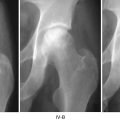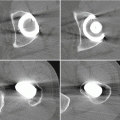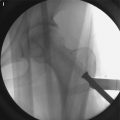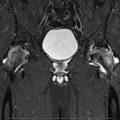Gender
Type of age (years)
Total
Men
Women
0–16
17–35
>35
Aseptic bone necrosis
14
11
4
12
12
25
Chronic osteomyelitis
25
23
15
15
18
48
Total osteonecrosis
39
34
19
27
30
73
Table 4.2 shows the demographic data of osteonecrosis in the Netherlands in 2004. In this sample, 55.3 % of the diagnosis osteonecrosis was found in men. Again, osteonecrosis was more frequently reported in adults aged above 35 years. The total number of osteonecrosis in the year 2004 was 76 patients. Chronic osteomyelitis, septic necrosis, was more often found (63.2 %) than aseptic bone necrosis (36.8 %). The number of patients with osteonecrosis has increased in 2004 compared with 2003. The number of men with osteonecrosis has increased, while the number of women with osteonecrosis remains the same. In addition there has been a small increase in the number of patients in each age category in 2004 compared with 2003. The same data of osteonecrosis for 2005 will be available next year, probably in May 2006.
Table 4.2
Demographic data of osteonecrosis in the Netherlands in 2004
Gender | Type of age (years) | Total | ||||
|---|---|---|---|---|---|---|
Men | Women | 0–16 | 17–35 | >35 | ||
Aseptic bone necrosis | 14 | 14 | 3 | 10 | 12 | 28 |
Chronic osteomyelitis | 28 | 20 | 14 | 14 | 20 | 48 |
Total osteonecrosis | 42 | 34 | 17 | 24 | 32 | 76 |
4.3.2 Europe
There are about 370 million people living in Europe. Information on demographic data of osteonecrosis is unknown for the rest of Europe. There is no centralized health service in Europe to collect and report these data on osteonecrosis. Some countries in Europe have more precise data but only data on their own country.
4.3.3 The United States
There are approximately 295 million people living in the United States. Demographics of osteonecrosis in the United States are not collected with very much precision and not kept up to date. There is published information that would indicate that there is an estimate of approximately 20,000 new cases of osteonecrosis of the hip in the United States every year [6]. The accumulated numbers of ON is between 0.3 million and 0.6 million people. However, that information is based upon several large series of total hip replacements in which 10 % of the patients had a total hip replacement because of osteonecrosis. Not taken into account are all the new cases of osteonecrosis which do not have a hip replacement. This could probably add another 5 or 10 % to the mix. The estimate is calculated at approximately 22,000 new cases of osteonecrosis of the hip in the United States every year [6]. These numbers are indeed very “soft” numbers.
Stay updated, free articles. Join our Telegram channel

Full access? Get Clinical Tree








